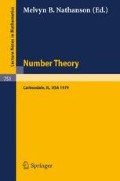Access this chapter
Tax calculation will be finalised at checkout
Purchases are for personal use only
Preview
Unable to display preview. Download preview PDF.
References
A. S. Fraenkel, J. Levitt, and M. Shimshoni, Characterization of the set of values f(n)=[nα], n=1,2,..., Discrete Math. 2(1972), 335–345.
J. E. Maxfield, Translated geometric progressions, J. Natur. Sci. and Math. 7(1967), 113–116.
D. J. Newman, On the number of binary digits in a multiple of three, Proc. Amer. Math. Soc. 21(1969), 719–721.
D. J. Newman and M. Slater, Binary digit distribution over naturally defined sequences, Trans. Amer. Math. Soc. 213(1975), 71–78.
J. B. Roberts, A curious sequence of signs, Amer. Math. Monthly 64(1957), 317–322.
H. G. Senge and E. G. Straus, PV-numbers and sets of multiplicity, Periodica Mathematica Hungarica 3(1973), 93–100.
K. B. Stolarsky, Power and exponential sums of digital sums related to binomial coefficient parity, SIAM J. Appl. Math. 32(1977), 717–730.
_____, The binary digits of a power, Proc. Amer. Math. Soc. 71(1978), 1–5.
_____, Integers whose multiples have anomalous digital frequencies, Acta Arith., to appear.
Author information
Authors and Affiliations
Editor information
Rights and permissions
Copyright information
© 1979 Springer-Verlag
About this chapter
Cite this chapter
Stolarsky, K.B. (1979). The number of bits in a product of odd integers. In: Nathanson, M.B. (eds) Number Theory Carbondale 1979. Lecture Notes in Mathematics, vol 751. Springer, Berlin, Heidelberg. https://doi.org/10.1007/BFb0062715
Download citation
DOI: https://doi.org/10.1007/BFb0062715
Published:
Publisher Name: Springer, Berlin, Heidelberg
Print ISBN: 978-3-540-09559-0
Online ISBN: 978-3-540-34852-8
eBook Packages: Springer Book Archive

